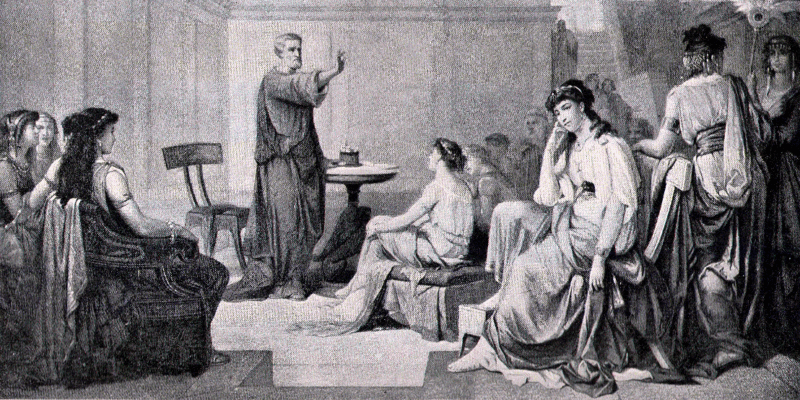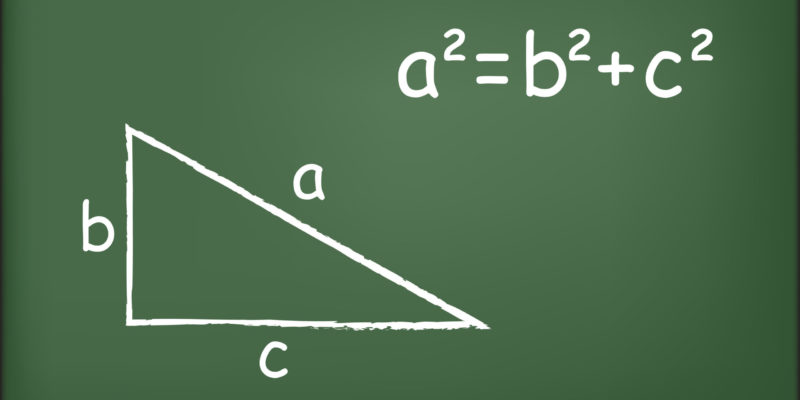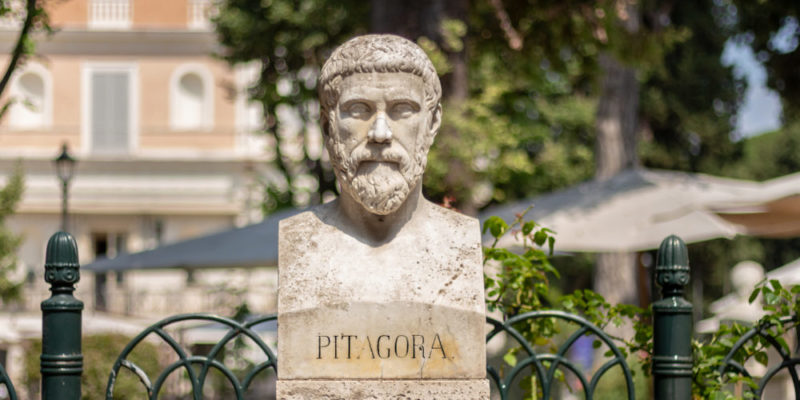We explain who Pythagoras was, how he was trained and what the Pythagorean Brotherhood was. In addition, its various contributions and characteristics.
Who was Pythagoras?
Pythagoras of Samos, also known simply as Pythagoras, was a philosopher and mathematician of Ancient Greece considered one of the great thinkers of the pre-Socratic doctrine, that is, of the previous or not influenced by the thought of the great Greek philosopher Socrates .
He is considered the first pure mathematician since this discipline occupied mainly (although not exclusively) his interests, and we still retain some of his theorems and postulates, especially in geometry and arithmetic.
His contributions to Western thought were key and central despite the fact that no text of his authorship was preserved and it is difficult to discern his thinking from that of his disciples (who quoted their teacher more or less indiscriminately).
Birth of Pythagoras
Pythagoras was born in the Greek city of Psalms, in Ionia of 569 BC (approximately). His father was Mnesarco, a merchant from the city of Tire, and his mother a local named Pythais. There is no certain date of birth, or more accurate information.
Pythagoras Formation

It is assumed that Pythagoras would have accompanied his father on his many business trips , which would have given him the opportunity to cultivate from very early times, thus learning to play the lyre, recite Homer, and write poetry .
Three philosophers are usually mentioned among his mentors: Ferécides de Siros, Thales de Mileto and his pupil Anaximander, all names of importance in the panorama of knowledge of the time.
However, in ancient times it was thought that the wisdom of Pythagoras came from his numerous travels through the kingdoms of Arabia, Phenicia, Egypt, Babylon and even India , from which he would have inherited vegetarianism , secrecy, the rejection of ready-made clothes with animals and a certain vocation for purity.
The Pythagorean Brotherhood

In the Italian city of Crotona , around 522 BC, Pythagoras settled after being a prisoner of war of the Persian Emperor Cambyses II, who invaded Egypt in 525 BC
In this Italian city he founded his academy, known as "the Pythagorean brotherhood" , in which both men and women were accepted and called themselves "mathematicians" ( matematikoi ) because they considered that reality is mathematical in nature.
The brotherhood had 300 followers , known as the Pythagoreans, who had no possessions, practiced vegetarianism and were divided between members of the hard group and listeners (called "accusmatics" and who did not live in the temple).
Around 500 BC the Pythagoreans assumed a certain political role and fragmented into houses , until they were attacked and annihilated in 460 BC by their political opponents.
Pythagorean principles

Pythagoras and his disciples were guided philosophically by the following principles:
- Reality, in its deepest perception , is mathematical in nature. Things are numbers.
- The philosophy can be a path to spiritual purification.
- The human soul can rise high enough to merge with the divine.
- Certain symbols of a mystical nature are signs as sacred.
- All members of the Pythagorean brotherhood must maintain absolute secrecy regarding their beliefs and practices.
Pythagoras areas of interest
The main areas of interest of Pythagoras and the Pythagoreans was mathematics (especially geometry and arithmetic) , considered as the basis of all kinds of knowledge. They also had an interest in music, astronomy, and metaphysics. Its precepts were both scientific and religious.
Contributions of Pythagoras

The main contributions of Pythagoras were:
- Math . Pythagoras formulated the well-known theorem that bears his name, according to which "the sum of the square of the legs is equal to the square of the hypotenuse." He is also credited with the geometric construction of the first perfect solids, the discovery of perfect numbers and friendly numbers, as well as polygonal numbers. His work with triangles and the square root was foundational.
- Astronomy . He was among the first to point out that the morning star and the evening star are the same planet , Venus ; it also taught that the Earth was the center of the universe (geocentric model) and that the moon orbited it around the equator , although these discoveries are also attributed to Parmenides.
- Music . He is credited with discovering the laws of regular musical intervals, as well as the invention of the monochord, as well as teaching an ethical and medicinal use of music. Hence the notion that there is reciprocal harmony between the different systems of the universe and that, in that sense, astronomy, music, health and other areas were related.
Pythagoras works
No work by Pythagoras is preserved, despite the importance and centrality of his contributions to Western culture . The most important compilation of his philosophical thought dates back 800 years after his death , in the 3rd century AD.
Death of Pythagoras

Much is unknown about the death of Pythagoras although it is assumed to have occurred in 532 BC according to some sources , or in later years according to others, after the Pythagorean brotherhood was dismembered by their political rivals. According to the first version, he would have died in the city of Metaponto, where his tomb was exhibited in times of the Roman Empire .
Pythagoras Acknowledgments
Beyond the theories that still bear his name, the name of Pythagoras is honored with a lunar crater (Pythagoras) and an asteroid (6143) of the solar system .
Pythagoras Biographers
It is difficult to biograph Pythagoras, since there is no documentation of his time that attests to his life or his works . The versions produced later, by disciples or by late admirers, differ greatly from one another. In fact there are references to it in the Dialogues of Plato , but is known more as a literary figure than a historical record.
The above content published at Collaborative Research Group is for informational and educational purposes only and has been developed by referring reliable sources and recommendations from experts. We do not have any contact with official entities nor do we intend to replace the information that they emit.
Abubakr Conner brings a diverse skill set to our team, and covers everything from analysis to the culture of food and drink. He Believes: "Education is the most powerful weapon that exists to change the world." .
Leave a reply
Your email address will not be published. Required fields are marked *Recent post

Sport: What Is It, Types, Risks, Features, Characteristics and Examples

Dogs: Emergence, Features, Characteristics, Feeding and Breeds

Story: Definition, Elements, Structure, Features and Characteristics

